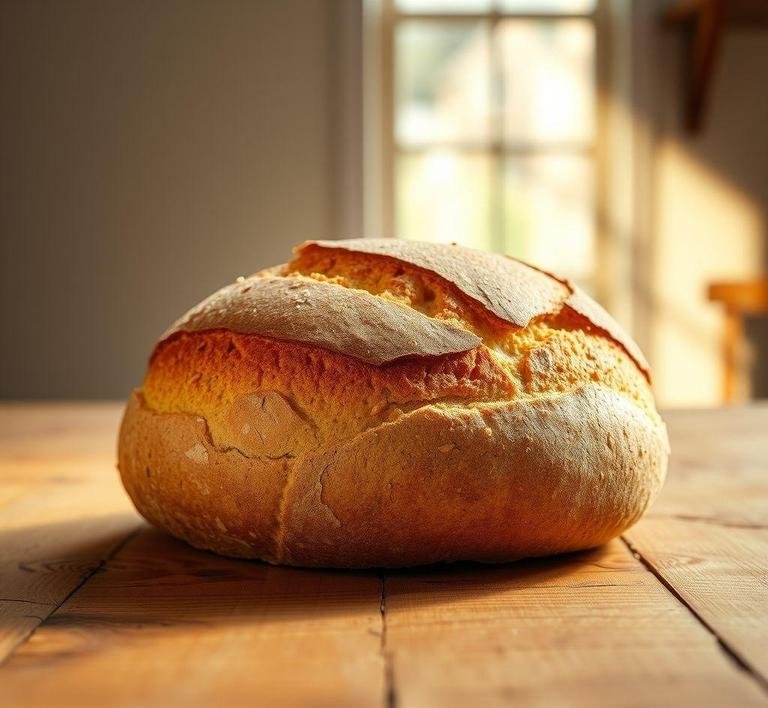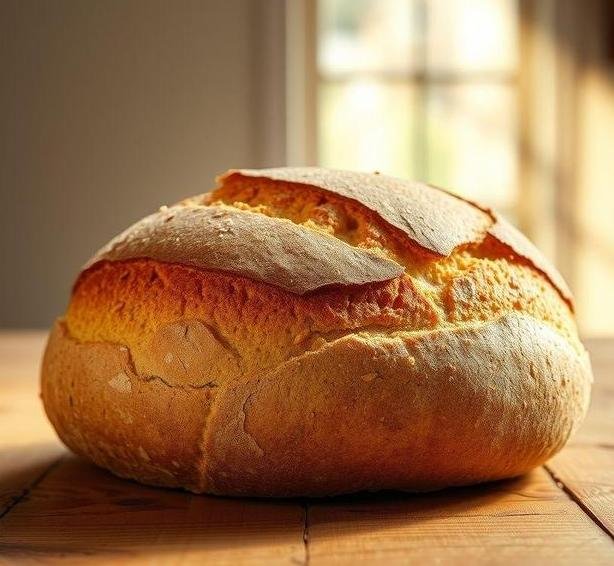Mary Berry’s Orange Wholemeal Victoria Loaf is a delightful twist on the classic British Victoria sponge, which is known for its light, airy texture and rich, buttery flavor. However, this loaf version embraces a healthier, more wholesome approach by incorporating wholemeal flour, offering a denser, heartier texture while still maintaining the signature citrusy notes. The addition of fresh orange zest and juice infuses the loaf with a bright, fragrant flavor that pairs beautifully with the natural sweetness of the cake. The wholemeal flour gives the loaf a slightly nutty taste and provides added fiber, making it an excellent choice for those seeking a more nutritious treat without compromising on taste.
While this recipe pays homage to the traditional Victoria sponge with its method and structure, the wholemeal flour, along with the tangy orange, elevates the loaf into something uniquely special. This is a perfect bake for any occasion, from afternoon tea to a light breakfast or snack, especially for those who enjoy a balance of sweetness and subtle tang. The loaf remains incredibly moist and tender, owing to the combination of butter, eggs, and yogurt. It’s a beautiful marriage of classic and contemporary, offering a taste of nostalgia with a modern twist.
Mary Berry’s Orange Wholemeal Victoria Loaf Recipe
Ingredients Needed

To make Mary Berry’s Orange Wholemeal Victoria Loaf, you’ll need a selection of simple ingredients, many of which you may already have in your kitchen. These are the essential components for the cake:
- Wholemeal Flour: This is the key ingredient that gives the loaf its dense yet moist texture. The wholemeal flour not only adds flavor but also boosts the nutritional value of the loaf by providing fiber and essential minerals like iron and magnesium.
- Self-Raising Flour: A mix of plain flour and a leavening agent, self-raising flour ensures that the loaf rises beautifully as it bakes. It’s a convenient ingredient that eliminates the need to add extra baking powder.
- Butter: Softened unsalted butter is preferred in this recipe. It contributes richness and a smooth texture to the batter, making the loaf moist and tender.
- Caster Sugar: A finer sugar that dissolves easily into the batter, caster sugar gives the loaf a delicate sweetness without any grainy texture.
- Eggs: Fresh eggs help bind the ingredients and provide structure. They also add to the moist texture of the loaf and contribute to its rich flavor.
- Orange Zest: This is where the loaf gets its unique flavor. Fresh orange zest provides a burst of citrus aroma that complements the rest of the ingredients perfectly.
- Orange Juice: The juice adds even more of that vibrant orange flavor, balancing out the richness of the butter and sugar.
- Greek Yogurt: For added moisture and a subtle tang, Greek yogurt is used in this recipe. It also enhances the texture, making the loaf tender and soft.
- Milk: A small amount of milk is used to loosen the batter if needed, helping to achieve the right consistency for baking.
- Baking Powder: If you’re using plain flour instead of self-raising flour, baking powder is added to ensure the loaf rises and becomes light and fluffy.
Equipment Needed
Before you begin, make sure you have the following tools at hand. These items will help streamline the process, ensuring your loaf turns out perfectly:
- Loaf Tin: A 2-pound loaf tin is ideal for this recipe. It provides the right size and shape for the loaf to bake evenly. Be sure to line it with parchment paper or lightly grease it with butter to prevent sticking.
- Mixing Bowls: You’ll need two mixing bowls-one for sifting the dry ingredients and the other for creaming the butter and sugar together. A large bowl is needed for combining all the ingredients.
- Electric Mixer or Wooden Spoon: While you can mix by hand using a wooden spoon, an electric mixer will make the creaming process much easier and quicker, helping the butter and sugar to blend to a smooth consistency.
- Zester or Grater: To extract the zest from the orange without the bitter pith, a fine zester or grater is essential.
- Measuring Cups and Spoons: Precision is key, so be sure to have accurate measuring cups and spoons to measure out your ingredients.
- Cooling Rack: After baking, the loaf should be allowed to cool on a wire rack to prevent it from becoming soggy from steam buildup.
Instructions To Make Mary Berry’s Orange Wholemeal Victoria Loaf
- Preheat the Oven: Begin by preheating your oven to 350°F (175°C). This ensures that the oven is at the right temperature to bake your loaf evenly.
- Prepare the Loaf Tin: Grease your 2-pound loaf tin with butter or line it with baking parchment. This will make it much easier to remove the loaf once it’s baked.
- Sift Dry Ingredients: In a large bowl, sift the wholemeal flour, self-raising flour (or plain flour and baking powder), and a pinch of salt together. Sifting helps to remove any lumps and evenly distributes the leavening agents.
- Cream Butter and Sugar: In another bowl, use an electric mixer or a wooden spoon to cream together the softened butter and caster sugar. Beat the mixture until it is light and fluffy, which will take about 4-5 minutes.
- Add the Eggs: One by one, add the eggs to the creamed butter and sugar mixture, ensuring each is fully incorporated before adding the next. If the mixture begins to look a bit curdled, add a spoonful of the flour mixture to bring it back together.
- Incorporate the Zest and Juice: Add the orange zest and orange juice to the batter, mixing until combined. This is where the loaf gets its delightful citrus fragrance.
- Fold in the Dry Ingredients and Yogurt: Gradually add the sifted dry ingredients into the wet mixture, folding gently with a spatula to avoid knocking the air out. Once most of the flour is incorporated, add the Greek yogurt and fold again until smooth.
- Transfer to the Tin: Pour the batter into the prepared loaf tin, smoothing the top with a spatula.
- Bake the Loaf: Place the tin in the preheated oven and bake for around 45-50 minutes, or until a skewer inserted into the center of the loaf comes out clean.
- Cool the Loaf: Once baked, remove the loaf from the oven and allow it to cool in the tin for 10 minutes. Then transfer it to a wire rack to cool completely.
Tips And Tricks
- Room Temperature Ingredients: Ensure that your butter, eggs, and yogurt are at room temperature before starting. Cold ingredients can cause the batter to curdle or result in an uneven texture.
- Don’t Overmix: When combining the dry and wet ingredients, mix just until combined. Overmixing can cause the loaf to become dense.
- Zesting the Orange: Be sure to zest the orange before juicing it. This way, the zest is fresher and easier to handle.
- Check for Doneness: Oven temperatures vary, so always check the loaf with a skewer a few minutes before the recommended time. If the skewer comes out clean, it’s done.
- Storage: The loaf keeps well for several days when stored in an airtight container. It can also be frozen, so you can enjoy it later-just slice it first and wrap it in cling film before freezing.
Mary Berry’s Orange Wholemeal Victoria Loaf is a perfect blend of classic baking with a modern, healthier twist. By using wholemeal flour and adding fresh orange zest and juice, the loaf provides a satisfying, delicious treat that’s slightly more nutritious than a traditional cake. Whether you’re a seasoned baker or just looking for a comforting, simple recipe to try, this loaf is sure to become a favorite in your repertoire. It’s perfect for sharing with friends over tea, serving at a family gathering, or enjoying as a sweet yet wholesome snack. The combination of flavors and textures is nothing short of delightful, and the baking process is straightforward, allowing you to enjoy a homemade treat with minimal fuss. So, grab your ingredients, preheat your oven, and let the wonderful aroma of freshly baked orange wholemeal loaf fill your kitchen!
Easy Recipe Variations For Mary Berry’s Orange Wholemeal Victoria Loaf

Mary Berry’s Orange Wholemeal Victoria Loaf is already a delightful blend of zesty citrus and wholesome wholemeal flour, but it lends itself beautifully to various adaptations that can make this classic even more exciting or suited to specific dietary needs. Below are some easy yet effective variations to try:
1. Nutty And Fruity Twist
If you’re someone who loves added texture and flavor, incorporating chopped nuts and dried fruit can bring this loaf to a whole new level. Walnuts, almonds, or hazelnuts add a satisfying crunch, while dried cranberries, raisins, or even chopped apricots infuse the loaf with bursts of sweetness. Simply fold ½ cup of your chosen nuts and ½ cup of dried fruit into the batter before baking. The nuts provide a wonderful contrast to the soft crumb, and the fruit pairs beautifully with the citrus.
2. Spices For A Warm, Cozy Touch
For a more autumnal or wintery version, a dash of cinnamon, ground ginger, or nutmeg can infuse the loaf with a warm spiciness. About 1 teaspoon of your chosen spice (or a blend) can be added along with the dry ingredients. The combination of orange and spice is comforting and evokes a sense of warmth that’s perfect for colder months.
3. Gluten-Free Option
For those avoiding gluten, Mary Berry’s loaf can be easily adapted to a gluten-free version. Swap out the wholemeal flour for a high-quality gluten-free flour blend. You might need to add an extra egg or a tablespoon of milk to achieve the desired batter consistency since gluten-free flours tend to absorb more liquid. Be sure to check that the baking powder you’re using is also gluten-free.
4. Vegan-Friendly Adaptation
To make this recipe vegan-friendly, you can replace the eggs with a flaxseed or chia seed egg substitute. For each egg, mix 1 tablespoon of ground flaxseed or chia seeds with 3 tablespoons of water, let it sit for a few minutes to thicken, and use it as you would eggs. Replace the butter with a plant-based alternative such as coconut oil or a dairy-free margarine, and swap the milk for almond milk or oat milk. These simple substitutions will allow you to enjoy a delicious vegan version of the loaf.
5. Chocolate Orange Variation
For those with a sweet tooth, incorporating chocolate into this loaf is a no-brainer. Add 100g of chopped dark chocolate or chocolate chips into the batter along with the flour. The bitterness of dark chocolate complements the tangy sweetness of the orange, creating a rich and indulgent loaf. If you’re feeling extra adventurous, a swirl of melted chocolate on top before baking can give it a beautiful glossy finish.
6. Citrus Overload: Double The Orange
While the recipe already calls for orange zest, you can ramp up the citrus flavor by adding orange juice to the batter as well. Replace a small portion of the milk with freshly squeezed orange juice (about 3-4 tablespoons) to intensify the orange flavor. This will give the loaf a wonderful tang and a hint of brightness that balances the wholemeal flour perfectly.
These easy variations allow you to experiment and personalize the loaf based on your preferences or dietary needs, ensuring that every bake is a new and exciting experience!
Storing Leftovers
If you’re lucky enough to have leftover slices of Mary Berry’s Orange Wholemeal Victoria Loaf (although they tend to disappear quickly!), proper storage is key to keeping the loaf fresh and moist for as long as possible.
1. Room Temperature Storage
For short-term storage (a few days), keep the loaf in an airtight container or wrap it tightly in cling film to prevent it from drying out. Store it in a cool, dry place away from direct sunlight. Wholemeal flour has a tendency to dry out quicker than white flour, so sealing it properly is crucial for retaining its moisture. This method should keep your loaf fresh for about 3-4 days.
2. Freezing For Longer Shelf Life
If you want to keep the loaf for longer, freezing is an excellent option. After the loaf has cooled completely, slice it into individual portions. Wrap each slice tightly in cling film or parchment paper, and then place the slices in a resealable freezer bag. This prevents the slices from sticking together and makes it easy to grab just one or two slices when needed. You can store it in the freezer for up to 2-3 months. When ready to eat, thaw at room temperature, or toast it lightly for a warm, fresh taste.
3. Reheating Leftovers
To bring leftover slices back to life, you can gently reheat them. A quick pop in the microwave for 15-20 seconds will warm them up, making the loaf taste as fresh as when it was first baked. For a crispier option, place the slices in a toaster or under a grill for a couple of minutes to give them a golden, slightly crunchy edge. The orange aroma will fill the room, making it hard to resist!
By storing the loaf properly, you ensure that every slice remains just as delicious as the first, whether you’re enjoying it a day after baking or weeks later.
What To Eat With Mary Berry’s Orange Wholemeal Victoria Loaf?
This orange-infused loaf is incredibly versatile and pairs well with a wide range of toppings and accompaniments. Whether you’re enjoying it for breakfast, afternoon tea, or dessert, here are a few delicious options to consider:
1. Butter And Marmalade
The simplest and most classic option is to spread a layer of salted butter on a warm slice. The rich butter melts into the dense, slightly nutty crumb, creating a beautifully balanced flavor. For an added twist, top the buttered slice with a spoonful of tangy orange marmalade, which complements the citrus notes in the loaf perfectly.
2. Cream Cheese And Honey
For a creamy, sweet contrast, spread a layer of cream cheese on your loaf and drizzle it with honey. The slight tang of the cream cheese pairs wonderfully with the loaf’s orange flavor, while the honey adds a smooth, natural sweetness. This combination is perfect for a mid-morning snack or a light lunch option.
3. Fresh Fruit
A slice of Mary Berry’s loaf is delicious when paired with fresh fruit. Try it with sliced strawberries, oranges, or a handful of mixed berries for a vibrant and refreshing side. The natural sweetness and juiciness of the fruit enhance the loaf’s citrusy brightness, and the wholemeal loaf provides a hearty base that complements the freshness of the fruit.
4. Yogurt And Granola
If you’re looking for a more substantial meal, try pairing your slice of loaf with some Greek yogurt and a sprinkle of granola. The creamy yogurt offers a cooling contrast to the loaf’s zesty warmth, while the crunchy granola adds texture. A few scattered berries or a drizzle of maple syrup on top can elevate this combo to a full breakfast or brunch dish.
5. Tea Or Coffee
No loaf is complete without a warm beverage. Mary Berry’s Orange Wholemeal Victoria Loaf is the perfect companion to a nice cup of tea, especially a citrus-based variety like Earl Grey or chamomile. If you’re more of a coffee person, a medium roast or even a frothy cappuccino can balance the loaf’s sweetness and provide a delightful contrast.
6. Ice Cream
For dessert, try serving a slice of the loaf with a scoop of vanilla or orange-flavored ice cream. The creamy cold ice cream pairs beautifully with the warmth of the loaf, making for a deliciously comforting treat, especially when served with a drizzle of chocolate or caramel sauce.
Conclusion
Mary Berry’s Orange Wholemeal Victoria Loaf is more than just a simple cake; it’s a versatile, wholesome treat that can easily be tailored to suit your tastes or dietary preferences. Whether you choose to add nuts, swap ingredients for gluten-free or vegan versions, or experiment with spices, the loaf remains a comforting and delicious choice for almost any occasion.
From storing leftovers to pairing it with your favorite foods, this loaf is a fantastic all-rounder. Whether enjoyed with butter and marmalade, paired with fresh fruit and yogurt, or served as part of a cozy afternoon tea, it’s bound to please every palate. And, with so many easy variations and pairing possibilities, you’ll never get tired of baking this delightful loaf.
FAQs
What Makes Mary Berry’s Orange Wholemeal Victoria Loaf Different From A Traditional Victoria Sponge?
Mary Berry’s orange wholemeal victoria loaf adds a unique twist to the classic Victoria sponge by using wholemeal flour instead of plain flour, making it heartier and more nutritious. The addition of fresh orange zest and juice provides a citrusy flavor that lightens the texture and adds a refreshing aroma, setting it apart from the traditional version which typically relies on butter and plain flour for a lighter, more delicate crumb.
Can I Substitute The Wholemeal Flour With Regular Plain Flour In This Recipe?
Yes, you can substitute the wholemeal flour with plain flour if you prefer a softer, less dense loaf. However, using wholemeal flour contributes to a denser, richer texture, and it also adds more fiber and nutrients to the loaf. If you decide to switch to plain flour, you might want to slightly reduce the amount of liquid (like the orange juice) to maintain the right consistency.
How Do I Ensure My Mary Berry Orange Wholemeal Victoria Loaf Rises Properly?
To ensure that your loaf rises beautifully, make sure you’re using fresh baking powder and that your ingredients are at room temperature, particularly the eggs and butter. Be sure to mix the batter gently, as overmixing can result in a denser loaf. Also, preheat your oven to the correct temperature and check the loaf with a skewer to ensure it’s fully cooked before removing it from the oven. If the skewer comes out clean, your loaf is ready!


